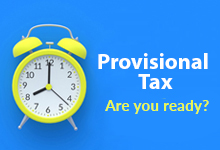
“Death, taxes, and childbirth! There’s never any convenient time for any of them.” (Margaret Mitchell)
What is provisional tax?
Provisional tax allows corporate and individual provisional taxpayers to pay their annual income tax in advance by making two or three payments during a tax year.
The aim is to prevent taxpayers from facing large income tax liabilities that are only revealed at the end of the year of assessment, when the annual personal income tax (PIT) return ITR12 or the annual corporate income tax (CIT) return ITR14 is filed in January.
While provisional tax payments can assist taxpayers by spreading their income tax liability over the tax year, they also create additional administrative obligations such as completing and submitting a provisional tax return (IRP 6) on time, twice or thrice a year. What’s more, they increase the risk of penalties, most notably under-estimation penalties.
Luckily you have us in your corner.
Are you a provisional taxpayer?
Companies are automatically provisional taxpayers. Individuals who receive income other than a salary may also be provisional taxpayers, depending on various criteria. Because SARS places the onus on you to determine if you are liable for provisional tax, it’s best to check your provisional tax status with us.
The 3 provisional tax payments
The first compulsory provisional tax payment is due within six months of the start of the year of assessment. So, if your or the company’s 2025 tax year commenced on 1 March 2024, the first provisional tax payment was due on 31 August last year.
This forward-looking payment is based on half of the total estimated tax for the full year, less employees’ tax already paid and any applicable tax credits and rebates.
The upcoming second compulsory provisional tax payment deadline is the last working day of the year of assessment (on 28 February if your tax year started on 1 March). It works somewhat differently, and the rules are far stricter – with harsh penalties for under-estimating taxable income for the year.
A third optional payment can be made after the end of the tax year, but before the issuing of the annual income tax assessment by SARS each year.
Crunch time!
The provisional return for the second period to 28 February is retrospective and based on the total estimated tax for the full tax year (less the first period provisional tax and employees’ tax already paid, and any applicable tax credits and rebates).
The second estimate must be quite accurate as heavy under-estimation penalties apply.
- Where the taxable income is less than R1 million; and the second period estimate is less than 90% of the actual taxable income and less than the ‘basic amount’ (taxable income assessed for latest preceding year of assessment), a 20% penalty is imposed on the difference between the employees’ and provisional tax already paid and the lesser of normal tax on 90% of the actual taxable income or normal tax on the basic amount, after deductible rebates.
- Where the taxable income is more than R1 million; and the second period estimate is less than 80% of the actual taxable income, a 20% penalty is imposed on the difference between the employees’ and provisional tax already paid and the normal tax on 80% of actual taxable income after deductible rebates.
Bear in mind that SARS can ask for your estimate to be justified, so you will need accurate records of all the source documents and calculations used to determine your estimate. Even so, SARS can increase the estimate if they are dissatisfied with your amount, and this is not subject to an objection or appeal.
To avoid this, SARS provides the following advice: “the amount of the estimate must be determined sensibly and by careful reasoning and judgment, in a mathematical manner, and using experience, common sense and all available information”.
We can ensure this holds true for your provisional tax, be it corporate or individual.
Further penalties to watch out for…
- Even if you or your company owes no tax, a ‘nil’ return showing taxable income as equal to zero must still be filed timeously. Failing to do so will attract administrative penalties.
- If an IRP6 is filed more than four months after the deadline, SARS will consider a ‘nil’ return to have been submitted. Unless the actual taxable income really was zero, an under-estimation penalty will also apply to a late submission.
- Not making your provisional tax payments on time will also result in an immediate late payment penalty, calculated at 10% of the provisional tax amount, regardless of whether it’s not paid at all or simply paid late.
- Interest will also be levied on the underpayment of provisional tax because of under estimation, and on late payments.
Rely on our expertise
The rules of provisional tax are daunting and confusing, and yet SARS holds provisional taxpayers responsible for their tax affairs. That’s why it makes sense to allow the experts to prepare and/or review your provisional tax and income tax returns prior to submission.




